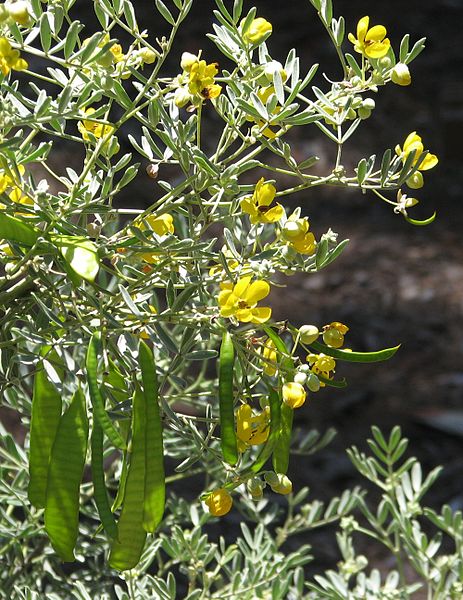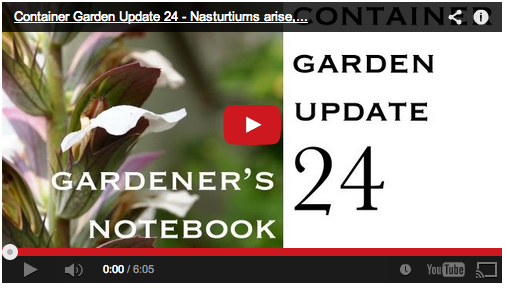Feathery Cassia (Senna artemisioides)
Another possibility for mine and my neighbors Southern California gardens. I have seen this out in the Palm Springs area where my sister has lived for 20+ years and it does look very attractive as part of a xeriscape environment. I am not sure if I have enough sun here in my garden, but there might be a couple of areas where it would fit. According to the Wikipedia page it can grow up to 3 meter, which might the a little large for some gardens. I don’t think I have ever seen it grow this large in the gardens where i have seen it, though.
- “Blunt-leaved Senna” (and spelling variants) redirects here. This name is also used for Senna obtusifolia, a large shrub common in warm humid regions.
Senna artemisioides is a flowering plant in the family Fabaceae. It is commonly known as Silver Cassia or Feathery Cassia – although “cassia” generally refers to the largest-growingCassiinae. Some of its distinct subspecies also have common names of their own. This plant is endemic to Australia, where it is found in all mainland states and territories, except forVictoria.
This is a shrub that grows up to 3 metres in height. It has pinnate leaves with between 1 and 8 pairs of leaflets. It produces an abundance of yellow flowers in winter and spring which are about 1.5 cm in diameter, followed by 2 to 7 cm long flat green pods which age to dark brown.
The species adapts to a wide range of climatic conditions, although it is susceptible to frost, particularly when young. It prefers dry, well drained sites with full sun. As an ornamental plant, it is propagated readily from seed, which should first be soaked in boiling water.[1]
This plant has gained the Royal Horticultural Society‘s Award of Garden Merit.[2]
Previously in the Interesting Plant series:
- Red Stick Dogwood (Cornus alba ‘Sibirica’)
- Japanese Maple (Acer palmatum)
- Kousa Dogwood (Cornus kousa)
- Giant Chalk Dudleya (Dudleya brittonii)
- Sunrose (Helianthemum nummularium)
- Australian/New Zealand Tea Tree (Leptospermum scoparium)
- Brugmansia Sanguinea
- Calico Monkeyflower (Mimulus pictus)
- Colocasia Esculenta
- Acer palmatum ‘Sango-kaku’ (Coral Bark Japanese Maple)
- Linderniaceae (formerly Torenia) Kuaui Deep Blue
- Passiflora (Passion flower)
- Firewheel Tree (Stenocarpus sinuatus)
- Anemone
- Allium Cowanii
- Symphyotrichum oblongifolius (Purple Aster)
- Hemerocallis ‘Derrick Cane’ (Daylily)
- Agastache ‘Aztec Rose’
- Rudbeckia hirta Moreno
- Kalanchoe Tomentosa
- Albuca namaquensis
- Hosta ‘Remember Me’
- Dahlia ‘Clair de Lune’
- Lovely silver-tinged fern on campus of Oberlin College, Ohio
- Tricolor Beech (Fagus sylvatica Purpurea Tricolor)
- Climbing Hydrangea (Hydrangea anomala petiolaris)
- Eremurus ‘Lemon Meringue’
- Lupine “Sunrise” (Lupinus hartwegii)
- Chinese Fringe Flower (Loropetalum chinense)
- Streptocarpus ‘Harlequin Blue’
- Nigella damascena (love-in-a-mist, ragged lady)
- Epiphyllum (Orchid Cactus)
- Sempervivum ‘Westerlin’
- Gladiolus ‘Kings Lynn’
- Hosta sieboldiana ‘Dorothy Benedict’
- Begonia “Escargot”
- Asparagus Pea (Psophocarpus tetragonolobus)
- Rosa banksiae (Lady Banks’ Rose)
- Primula ‘Victoriana Silver Laced Black’
- Oxalis versicolor
- Poached Egg Plant (Limnanthes douglasii)
- Parisian Carrots
- Fritillaria imperialis Rubra Maxima
- Clematis “Fascination”
- Swiss Chard “Bright Lights”
- Georgia Rattlesnake Melon
- Dianthus Barbathus “Green Ball” or “Green Trick”
- Coleus “Religious Radish”
- Black Forest Calla Lily
- Black Bamboo
Interesting Plant is a series from A Gardener’s Notebook blog and podcast that highlights the most interesting plants I find in my Internet and real-world travels — Douglas






